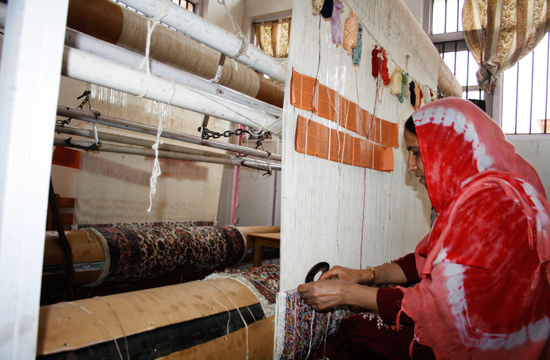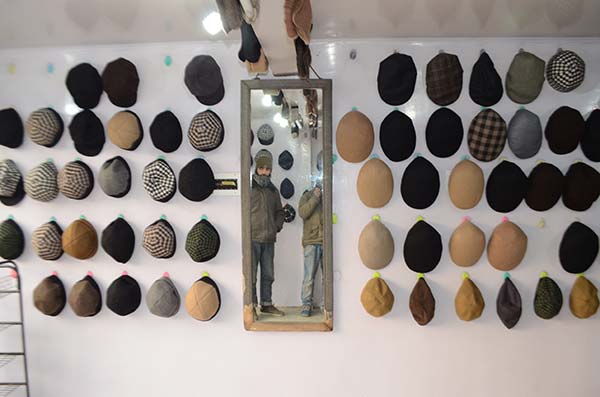Kashmir produces one of the world’s most expensive handmade carpets but the artisans associated with the lucrative Qaleen industry are abandoning the trade of minimal returns and looking for better avenues to earn a decent living. A 650-crore strong industry is moving towards a slow death, SYED ASMA reports.

From the last 30 years, Ghulam Nabi Ganie has been weaving the expensive Kashmiri carpets locally known as Qaleen. But his financial status has remained stagnant over these years. “I can’t afford to build a new house. We live in our ancestral house. Our family is constantly growing. I am earning the same as I was 10 years ago. Back then, it was manageable. But with rising inflation, the survival has become difficult,” he says.
Ganie hails from Hajibagh in central Kashmir’s Budgam district. Unlike many people in his village, he is landless and depends on earnings from carpets he weaves to run his family. Ganie lives in a house which was built by his father when they were seven members. The family has grown. Now there are 18 members. He has two brothers and two sisters. Both sisters are yet to be married. “How long will they sit at home? This is becoming a curse now,” Ganie’s mother, Mokhte laments.
Ganie’s day starts at 8 in the morning and ends at 6 in the evening. As darkness falls, it is difficult to work with cotton and silk threads used intricately in weaving the carpet. “Electricity supply is erratic. It is usually absent in our area. I can’t take rest as it affects my earning. I have to sit here for the whole day,” he says.
This craft of weaving Qaleens is practiced mostly by people in rural areas of Kashmir including Baramulla and Budgam districts. However, there are a few colonies along Dal Lake and Achar Lake in Srinagar city where many artisans are associated with the weaving. The carpets are woven on a large wooden loom having two logs fixed horizontally on which white threads are carefully tied which form the base of the carpet.
In Kashmir, either cotton or silk threads are used as the base of the carpet. The deadline for weaving a carpet is fixed by the middleman who buys the carpets from the artisans. The larger the carpet, the more money it fetches. A medium sized carpet of 5X7 feet is woven in six months and fetches Rs 12,000. The same carpet is sold by middlemen to the traders at an exorbitant rate. Sometimes, the same carpet fetches Rs 60,000 but such benefits are unknown to artisans like Ganie.
Being illiterate, he does not have any idea about markets of carpets in or outside Kashmir. “I do not know the price at which Qaleens are sold outside but I know that the man I work under, my wuastad (middleman) is a big man. His clothing, his life style, his big car, signifies his financial status. But he is good man. He lends me money whenever I need,” says Ganie.
Most middlemen who purchase Qaleens from weavers live in urban areas of Kashmir valley. They have either their own showrooms outside the state or sell the carpets to the people who own showrooms. The carpets are sold at exorbitant rates which can go up to lakhs of rupees. The price depends upon the material used in the carpets. The carpets are made of three types; silk on silk, silk on cotton and art silk on cotton. The first one is the most expensive and the last one is the least.
Ganie’s tale is a reflection of the plight of the impoverished carpet weavers of Kashmir valley. Although the carpet trade is Rs 650 crore strong with a majority of products worth Rs 412.45 crores exported to United States, Germany, France, United Kingdom and Gulf countries, the huge prices haven’t changed the lives of the artisans. Kashmiri carpet is among the most expensive handicraft products manufactured in Kashmir. There are around 19 showrooms owned by the state government out of which 11 are based outside the state.
In the past, the artisans used to encourage their children to help them in weaving the carpets which passed on the art from one generation to another. However, the trend has changed because the trade fetches returns which are not sufficient for survival. “I couldn’t educate my siblings and I am sure the same tragedy will happen to my kids. Till they were in primary classes, it was fine. But as their expenses increase, they too will be asked to leave their studies.”
With the art fetching minimal returns, Ganie’s two brothers and many fellow workers have discontinued carpet weaving and have instead become manual laborers, making Rs 300 per day, three times more than what Ganie earns. He says most of
















I am looking for 5 x 7 sized carpets woven in silk for end use. We are travelling to kashmir in november for family vacation alongwith another 3 couples.
Would be interested to buy from Artisans of Badgaum as mentioned in this aricle.
pl.contact with phone and address
regards.
r.v.hegde